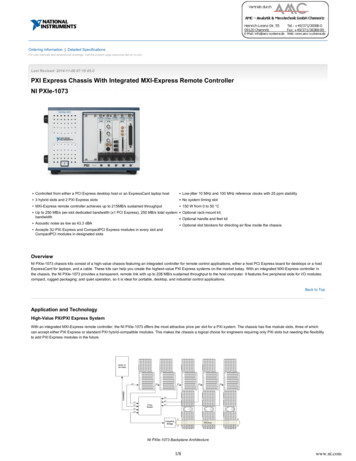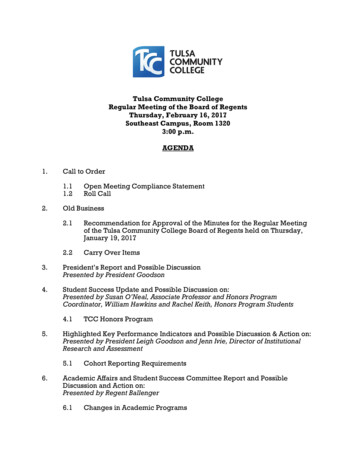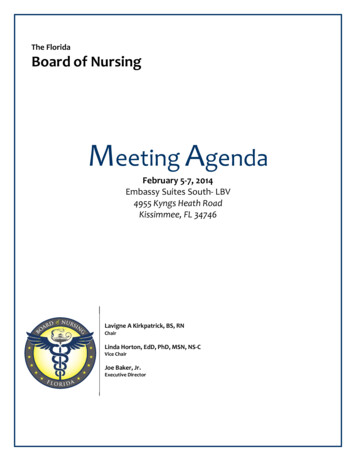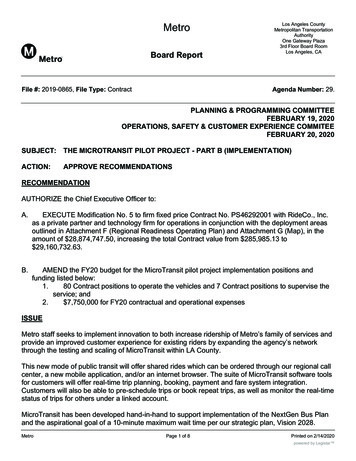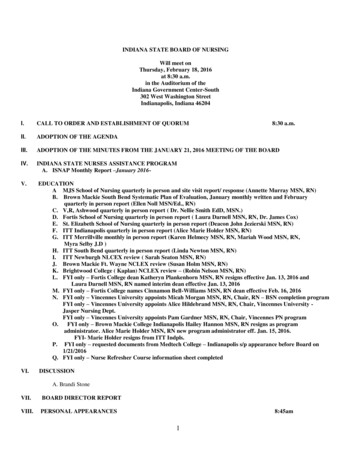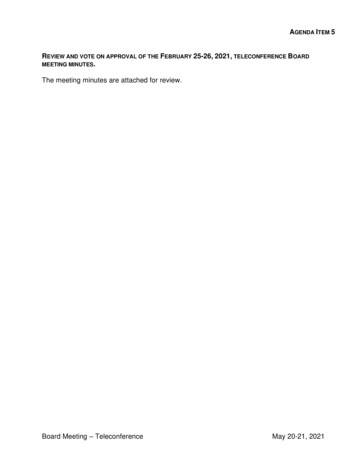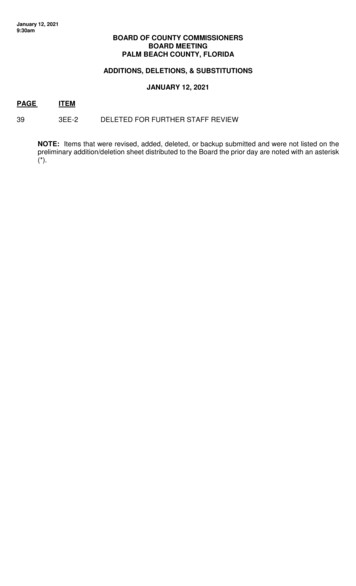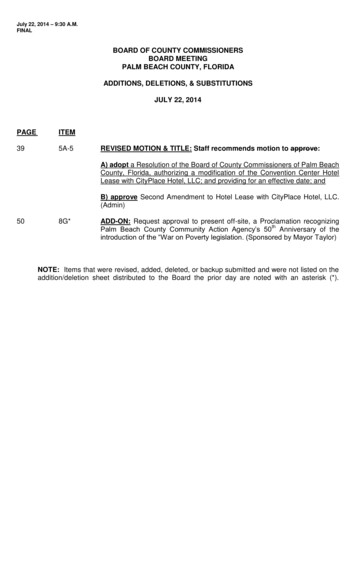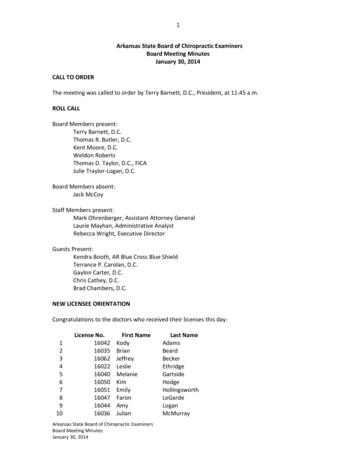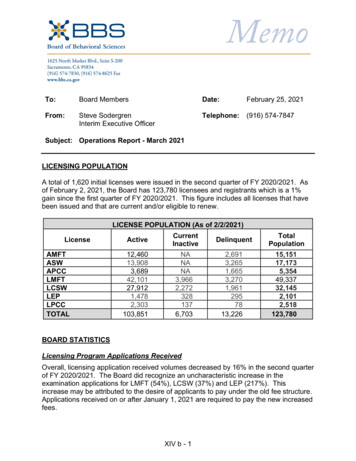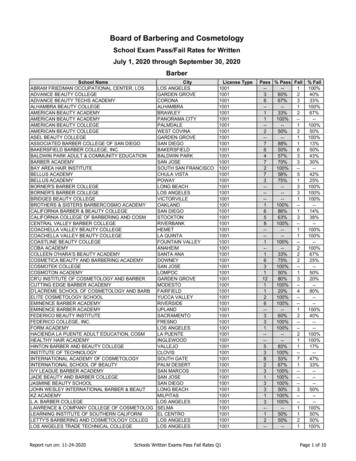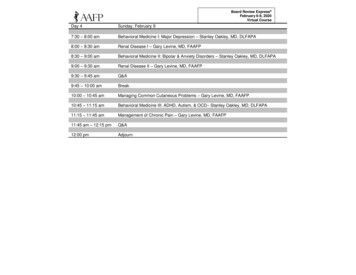
Transcription
Board Review Express February 6-9, 2020Virtual CoursegeorDay 4Sunday, February 97:30 – 8:00 amBehavioral Medicine I: Major Depression – Stanley Oakley, MD, DLFAPA8:00 – 8:30 amRenal Disease I – Gary Levine, MD, FAAFP8:30 – 9:00 amBehavioral Medicine II: Bipolar & Anxiety Disorders – Stanley Oakley, MD, DLFAPA9:00 – 9:30 amRenal Disease II – Gary Levine, MD, FAAFP9:30 – 9:45 amQ&A9:45 – 10:00 amBreak10:00 – 10:45 amManaging Common Cutaneous Problems – Gary Levine, MD, FAAFP10:45 – 11:15 amBehavioral Medicine III: ADHD, Autism, & OCD– Stanley Oakley, MD, DLFAPA11:15 – 11:45 amManagement of Chronic Pain – Gary Levine, MD, FAAFP11:45 am – 12:15 pmQ&A12:00 pmAdjourn
Behavioral Medicine I:Major Depression in Adultsand Special PopulationsStanley P Oakley, Jr, MD, DLFAPAProfessorDepartment of Psychiatric MedicineBrody School of MedicineGreenville, North Carolina
AAFP Board Review:Express
AAFP Board Review:Supersonic Overdrive
Disclosure StatementIt is the policy of the AAFP that all individuals in a position to controlcontent disclose any relationships with commercial interests uponnomination/invitation of participation. Disclosure documents arereviewed for potential conflicts of interest. If conflicts are identified, theyare resolved prior to confirmation of participation. Only participants whohave no conflict of interest or who agree to an identified resolutionprocess prior to their participation were involved in this CME activity.All individuals in a position to control content for this session haveindicated they have no relevant financial relationships to disclose.
Most of what follows is true.
Learning Objectives1. Recognize the differential diagnosis and clinicalpresentation of major depression in adults and inspecial populations (geriatric, pregnant, andpostpartum).2. List the pharmacotherapeutic options for treatmentof these conditions.
1. Which of the following is true with regard toscreening for depression?A. Brief, 2-question screens for depression areequivalent to longer instrumentsB. The Edinburgh Postnatal Depression Scale shouldnot be routinely used at the first postpartum visitC. There are few standardized scales that can be usedfor screening for depressionD. The USPSTF does not recommend screening adultsand adolescents for depression
Depression Screening USPSTF guidelines recommend screening adults fordepression. Can use following scales:‾‾‾‾ Zung Self-Rating Depression ScaleBeck Depression InventoryPHQ-9General Health Questionnaire, Center for Epidemiologic StudiesDepression Scale‾ Quick Inventory of Depressive Symptomatology (QIDS)‾ Geriatric Depression ScaleBut
Depression Screening A “yes” response to the following2 questions may be as effective as using longerscreening tools. (USPSTF, 2002) Over the past 2 weeks, have you ever felt down,depressed, or hopeless?Have you felt little interest or pleasure in doing things? (This is a simplified PHQ-2)
Depression: Screening USPSTF found evidence is insufficient to recommend for oragainst routine screening of children (7-11 years old) fordepression USPSTF recommends screening adolescents (12-18 yearsold) and adults for depression in clinical practices withsystems in place for diagnosis, treatment, follow-up First postpartum evaluation should include screening fordepression‾Routine use of the Edinburgh Postnatal Depression Scaleimproves diagnosis rates
2. Which of the following is true about depressionand Persistent Depressive Disorder (dysthymia)?A. The depression associated with dysthymia is assevere as that of major depressive disorder (MDD)B. Lifetime risk is equal for women and menC. Depression is more common in medically ill patientsD. Dysthymic patients may have periods of “normal”mood that can last for 1 year
DSM-5 Diagnosis of Major Depression Requires5 or More of the Following Sx (for 2 weeks)1) Depressed mood2) Loss of enjoyment(anhedonia)3) Weight or appetite change4) Sleep changes5) Psychomotor changes(restlessness or slowing)6)7)8)9)Poor energyFeelings of guiltPoor concentrationThoughts of death (NOTE: #1 or #2 must bepresent)
Major Depression
Diagnosis of Persistent DepressiveDisorder (Dysthymia) Requires depressed mood for at least two years with no symptomfree period lasting longer than two monthsAlong with 2 or more of the following:Appetite or sleep changesDecreased energy or concentrationThoughts of guilt or deathPsychomotor changes (restlessness or slowing)Hopelessness
Dysthymia
Epidemiology of Depression Depression is common. Lifetime risk greater for women (20%-25%) than formen (10%) Community prevalence is about 5% Prevalence is higher (15%) in the medically ill.
3. Which of the following is true about treatmentsfor depression?A. If a patient does not respond to an SSRI within 2 weeks ofstarting it, a second antidepressant should be addedB. The medication of choice for depressed patients withseizures is bupropionC. Memory loss caused by ECT is often short term & reversibleD. Antidepressants are contraindicated if the patient isbreastfeeding
Etiologies of Depression – Drugs NarcoticsAntineoplastic agentsSedative hypnoticsCentrally acting antihypertensivesSteroidsAnxiolyticsAlcohol
Medical Screening for Depression History & Physical(Especially the neurological exam) CBC CMP TSH, Thyroid panel if TSH abnormal RPR
Features of EffectiveClinical Management Patient education (the diagnosis, treatment options, duration oftreatment and costs, side effects, goals of the treatment, recurrenceand relapse, etc.) Reassurance (such as, “depression is a medical illness, not acharacter defect or weakness; recovery is the rule, not the exception;treatments are effective; an effective treatment can be found fornearly all patients,” etc.) Regular monitoring for symptoms and adverse effects Adjustments or changes in the treatment plan if response is lackingor suboptimal
Choice of Antidepressant All modern antidepressants are equally effectivePatient preferenceCostHistory of prior response to specific medicationResponse of first-degree relative to specific medicationUse one antidepressant
4. Which class of antidepressant medication isgenerally avoided due to a potentially lifethreatening side effect?A. Selective Serotonin Reuptake Inhibitors (SSRIs)B. Monoamine Oxidase Inhibitors (MAOIs)C. Tricyclic AntidepressantsD. Serotonin-Norepinephrine Reuptake Inhibitors (SNRIs)
Treatment of Depression Usually begin with selective serotonin reuptakeinhibitors (SSRIs) Once-a-day dosing No titration 80% of the time Few side effects (GI, sexual) Safe in overdose
Selective Serotonin Reuptake Inhibitors (SSRIs) More activating Fluoxetine (Prozac)20 mgSertraline (Zoloft)50 mgParoxetine (Paxil)20 mgEscitalopram (Lexapro) 10 mgCitalopram (Celexa)20 mgFluvoxamine100 mg More relaxing
Treatment of Depression After 4 weeks, if partial response to SSRI, increasedose or change to another SSRI If no response to SSRI, try switching to anothercategory
Other Antidepressants Bupropion (Wellbutrin) 150-450 mg‾No sexual side effects, not with seizuresVenlafaxine (Effexor XR) 75-225 mg-Mixed nor-epi & serotoninDesvenlafaxine (Pristiq) 50-100 mg-Active metabolite of VenlafaxineNefazodone 50-100 mg‾No sexual side effects, sedatingMirtazapine (Remeron) 15-45 mg‾At low doses, sedating, appetite increasedDuloxetine (Cymbalta) 40-60 mg‾May be useful if chronic pain is present
New Antidepressants Vilazodone (Viibryd) 20-40 mg‾ Serotonin agonist and reuptake blocker Vortioxetine (Trintellix) 10-20 mg‾ Serotonin agonist and reuptake blocker Levomilnacipran (Fetzima) 20-40 mg‾ SNRI
Treatment (cont.) Can follow response to treatment with the QuickInventory of Depressive Symptomatology(QIDS) scale If no response to any newer agents, or if chronicpain is a large issue in the depression, consider atricyclic antidepressant
Tricyclic Antidepressants Desipramine (Norpramin) 50-150 mg‾ Less sedation‾ Maximum dosage up to 300 mg/day Nortriptyline (Pamelor) 50-100 mg‾ More sedation‾ Maximum dosage up to 125 mg/day Serum levels available
Monoamine Oxidase Inhibitors (MAOIs) Generally not used Dietary restrictions; if patients eat foods with tyramine,will get hypertensive crisis Problematic in acute medical crises or emergency roomsettings Oral drugs are phenelzine (Nardil) and tranylcypromine(Parnate) Transdermal patch – selegiline (Emsam)
Antidepressant Side Effects Tricyclics: anticholinergic effects, narrow-angleglaucoma, caution in bundle branch blocks, weightgain SSRIs: sexual dysfunction; hyponatremia SNRIs: mild anticholinergic, narrow-angleglaucoma, rare hepatic dysfunction Bupropion: seizure induction (0.4%)
Duration of Treatment For 1st episodes of depression, treat for 6-9 months. For recurrent depression, treat for at least 2 years. If patient relapses after successful treatment, 90% will respond to the same antidepressant.
Augmentation of Antidepressants Liothyronine (Cytomel) (T-3) 25-50 mcg q am Lithium carbonate 300-600 mg daily Response usually rapid, 7-9 days Bupropion (STAR*D study) Buspirone (STAR*D) Aripiprazole, quetiapine, lurasidone, brexpiprazole
Treatment of Depression If no response to multiple antidepressants, considera trial of electroconvulsive therapy (ECT) ECT: most effective treatment in patients with severeresistance or psychotic depression‾ Safe; memory loss is short-term, reversibleTranscranial Magnetic Stimulation (TMS) is an emergingoutpatient treatment that can be effective in treatment-resistantcases
New Treatments for DepressionTranscranial Magnetic Stimulation (TMS) - an emergingoutpatient treatment that can be effective in treatment-resistantcasesEsketamine (Spravato) – Nasal spray for treatment resistantdepression. Administered in REMS certified office. Side effectsinclude dissociation and increased blood pressure
Geriatric Depression ECA study revealed 3% prevalence ofdepression in the elderly Other studies suggest 10-15% prevalence Coexistence of depression in the medically illelderly ranges from 25%-50% 500 NC family physicians rated geriatricdepression in the top 3 clinical challenges
Geriatric Depression Geriatric depression may be underdiagnosed by 50%in primary care settings 80% of depression is treated by primary care providers Often comorbid with generalized anxiety or dementia
Depressive Symptoms in the Young Sadness Loss of interest (anhedonia) Guilt Suicidal ideation These are the EMOTIONAL symptoms ofdepression
Depressive Symptoms in the Old Loss of interest Insomnia Suicidal ideation Physical complaints These are the SOMATIC (vegetative) symptoms ofdepression
Suicide in the Elderly 12% of the population is over 65, they compose25% of successful suicides Increased risks include being single, widowed, or awhite male Older patients use more lethal means and are moresuccessful – they don’t make gestures
Pseudodementia Also known as reversible dementia of depression Major depression in the elderly can present withprominent memory complaints Some controversy over this being called a “dementia,”since no neurons are lost Resolves as depression is treated due to improvementin concentration
Psychotic Depression Elderly are slightly more likely to develop psychoticdepression 3.6% of the depressed elderly in the communitydevelop psychosis This increases to 20-45% of the elderly hospitalizedfor major depression
Psychotic Depression Usually has psychotic delusions; hallucinations notprominent Delusions either mood congruent or mood incongruent Mood congruent delusions usually nihilistic (rotting,diseased) Not responsive to antidepressants alone; requiresaddition of an antipsychotic for treatment, or ECT
Treatment of Geriatric Depression Usually begin with selective serotonin reuptakeinhibitors (SSRIs) Once-a-day dosing No titration 80% of the time Few side effects (GI, sexual) Safe in overdose
Treatment of Geriatric Depression Patient must have an adequate trial of medication Ranges from 4-12(!) weeks, but if no response at allby 4 weeks, it is unlikely response will develop later If partial response at 4 weeks, maximize dose andcontinue
Other AntidepressantsTolerated Well by the Elderly Bupropion (Wellbutrin) 50-100 mg Venlafaxine (Effexor) 37.5 mg Desvenlafaxine (Pristiq) 50 mg Nefazodone 25-50 mg Mirtazapine (Remeron) 7.5-15 mg Duloxetine 20-40 mg
Depression: Special Groups Pediatrics‾Fluoxetine and escitalopram only ones FDA-approved(7-17 years) Lactation‾Antidepressants are NOT contraindicated!‾In most cases, infant blood concentrations of TCAs andSSRIs have been below the detection limit ofcommercial labs & well tolerated‾Fluoxetine: can check infant blood levels at 6 weeks
Antidepressants in the Pregnant Patient Relapse risk 5x higher if antidepressant is stoppedSSRIs are first line‾‾Little added risk of PPHN with SSRI use in late pregnancy (2015study of 129K pregnancies)2015 CDC study of 27,000 pregnancies found 2X elevation ofbirth defect risks with fluoxetine and paroxetine in earlypregnancy, no associated risks with citalopram, escitalopram, orsertraline
Antidepressants in the Pregnant Patient TCAs also considered safe and effective SSRIs appear to have a more favorable side-effectprofile than TCAs One small study supports the use of venlafaxine‾ Informed consent is key
5. Which of the following is true of postpartumdepression?A. The “baby blues” typically resolve spontaneouslyby the 6th to 8th postnatal weekB. Patients are predisposed by prior history ofdepressionC. Therapy is more effective than medicationsD. It is not associated with perinatal stress
Postpartum Depression “Baby blues” Frequency range: 26 to 85% Characterized by mild depressive symptoms Lasts 1-2 weeks Treatment: supporti
AAFP Board Review: Express. AAFP Board Review: Supersonic Overdrive. Disclosure Statement It is the policy of the AAFP that all individuals in a position to control content disclose any relationships with commercial interests upon nomination/invitation of participation. Disclosure documents are reviewed for potential conflicts of interest. If conflicts are identified, they are resolved prior .
